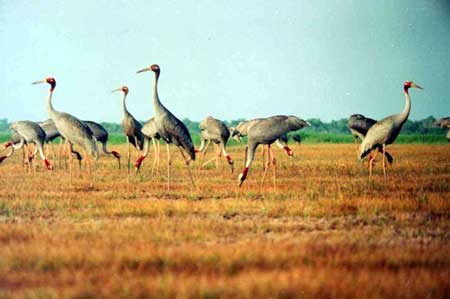Count the
birds that are counting on you
The
RSPB’s Big Garden Birdwatch (25-26 January)
More than
half a million people are expected to be watching their garden birds at the
weekend (25-26 January), for the RSPB’s Big Garden
Birdwatch.
And with
many of the UK's most common garden birds and other creatures in steep decline,
the charity needs participation more than ever.
The
weather plays an important role in the number of birds in gardens each winter
and experts are interested to see if the helter-skelter conditions around the UK
so far this year mean birds seem scarce, or they appear in their
droves.
Whatever
happens with the weather this weekend, the results will be compared with those
from winters in the past, stretching back to the first Big Garden Birdwatch in
1979. Any changes alert experts to track the winners and losers in the garden
bird world and long-term trends stand out even when year-to-year differences in
the weather are taken into account.
And this
year, for the first time in over thirty years, participants are being asked to
log some of the other wildlife they see in their gardens
too.
The RSPB
also wants to know whether people ever see deer, squirrels, badgers, hedgehogs,
frogs and toads in their gardens.
With the
charity’s new Giving Nature a Home campaign meaning even more people than ever
before are providing their wild creatures with new habitats, the RSPB will be
able to help build an overall picture of how important our gardens are for
giving all types of nature a home.
Also new
for 2014, is the RSPB’s LIVE bird counter, making it even easier to take
part. The counter can be accessed from the RSPB website and doesn't
even need to be downloaded - simply take your laptop, tablet or smartphone to
the window, enter the birds you see as you see them, while the clock counts down
your hour.
Martin
Harper, RSPB Conservation Director says: ”Winter has felt more like autumn for
many of us and this could have a significant impact on the number of birds in
our gardens.
“Birds
come into gardens for food when they can’t find it in the wider countryside but
if insects and berries continue to be available long into winter, numbers
visiting gardens may be down. The Big Garden Birdwatch will be really
interesting this year and will be a good indication of just how much the weather
affects their behaviour.
“The key
thing for the RSPB is that even if you feel you don’t have as many birds in your
garden compared to normal, we still desperately need your results. We will be
able to compare results to other mild winter years and compare regional trends,
so if you don’t see many birds, we still need to know, it’s really useful
information.
"The more
people that take part, the greater our understanding of the threats and the
solutions will be."
Starlings
hit an all time low in the 2013 Birdwatch with their numbers sinking by a
further 16 per cent from 2012. Numbers of house sparrows, which are of high
conservation concern, dropped by 17 percent in gardens compared to 2012, whilst
numbers of bullfinches and dunnocks were down by 20 per cent and 13 per cent
respectively.
These
worrying declines mirror the findings of the State of Nature report which was
launched earlier this year by 25 UK wildlife groups with the backing of Sir
David Attenborough. The report revealed that 60 per cent of the wildlife species
included are in decline, and one in ten of these could be the road to extinction
in the UK unless something is done to save them (See note
1).
The data
gathered on the mammal and amphibian species will be shared with conservation
partners so they can add it to their own records and will be used to help the
RSPB tailor its advice on giving nature a home so people can help their wild
visitors nest, feed and breed successfully.
Participants don’t have to actually count the other species like
hedgehogs and frogs during the birdwatch hour; just tell the RSPB whether they
have ever seen them in their gardens, at any time of
year.
Miranda
Krestovnikoff, RSPB President and West Country resident, says: “So many of us
spend time giving our nature a home, whether that's feeding garden
birds, putting up nestboxes or planting the right
things.
"And this
is the perfect opportunity to reap the benefits - it's so rewarding
seeing creatures taking up your hospitality.
“It’s easy
to take part and great fun; I can't wait to settle down with my children and a
cup of tea and we'll eagerly await some of our regular visitors. We're
all hoping that our nuthatch and bullfinch pay a visit during our
hour.
"The RSPB
urgently needs as many people to take part as possible. The more people that get
involved, the more we'll be able to understand which of our wildlife is most
under threat and take action."
Ends
For
further information and to arrange an interview, please
contact:
Tony
Whitehead, 01392 453754, 07872 414365
Gemma
Butlin 01767 693489/07967 818558
Heather
Griffiths 01767 693428
Photographs:
Images to
support this story are available from RSPB Images.
To access
an image, please click on the hyperlink below and then enter the user name and
password when prompted.
User
Name:
RSPB
Password:
BGBW14
Editor’s
notes:
3.
County by
County results for Big Garden Birdwatch 2013 are
attached.







)
